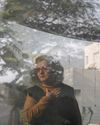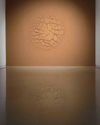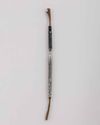
As I entered the venue of the India Art Fair (IAF), mounted at the NSIC Exhibition Grounds, New Delhi, from the 30th of January to the 2nd of February, I was baffled by the same question that bothered the art critic and writer Orit Gat, who summed up her consternation in the essay, “What Is an Art Critic Doing at an Art Fair?” The critic would be at home in a gallery or at all the proliferating biennials or at alternative platforms. What difference does it make when all these spaces showcase art?
The answer is very obvious. The objective of an art fair relies on the commercial aspect of the artwork. The critic shies away from market-oriented approaches, especially at spectacular events like art fairs that celebrate the triad – the gallery, the market and the artist. But is not a gallery exhibition commercial? Are not most of the sought-after art fairs of the world well-programmed and curated? Don’t they expand their programs and invite the general public, which includes various constituencies such as young artists, art historians, critics, journalists and local viewers to partake in their annual spectacle?
I was also wondering about what Walter Benjamin would have thought about the Great Exhibition of 1851, one of the earliest international art fairs held in Europe. How would the critic in him have responded to the spectacle of industrialization and mass production as displayed in a city like London? His response would be different to what Charles Dickens and R. H. Horne wrote about in the journal Household Words. They spoke effusively of “the machinery of our manufactures, with all their complex powers, their wonderful strength, velocity, and minutely precise manipulations.”
Denne historien er fra July 2020-utgaven av Art India.
Start din 7-dagers gratis prøveperiode på Magzter GOLD for å få tilgang til tusenvis av utvalgte premiumhistorier og 9000+ magasiner og aviser.
Allerede abonnent ? Logg på
Denne historien er fra July 2020-utgaven av Art India.
Start din 7-dagers gratis prøveperiode på Magzter GOLD for å få tilgang til tusenvis av utvalgte premiumhistorier og 9000+ magasiner og aviser.
Allerede abonnent? Logg på

Parts, Wholes And The Spaces In Between
Sonal Sundararajan introduces Samira Rathod's free-spirited and rebellious explorations in the world of architecture, furniture and design.

"The Fine Art of Going to the Pictures."
Dr. Banerjee in Dr. Kulkarni's Nursing Home at Chemould Prescott Road brings together 26 paintings featuring a series of dramatic scenes from Hindi and Bengali films. In conversation with Abhay Sardesai, artist Atul Dodiya talks about childhood trips to movie halls, painted figures gripped by tension, and the closeness and remoteness of cinematic images.

"To Finally Have Something of Your Own to Mine."
Dayanita Singh is the recipient of the coveted 2022 Hasselblad Award. Keeping the photograph at the centre, she speaks to Shreevatsa Nevatia about books, book objects, photo novels, exhibitions and museums.

OF DIVINE LOSS
Shaurya Kumar explores the relationship between the subject and object of devotion, finds Aranya.

THE PAST AND ITS SHADOWS
Neha Mitra visits two shows and three artists in Mumbai.

FORCE OF NATURE
Alwar Balasubramaniam dwells on absences and ephemeralities in his new work, states Meera Menezes.

SHAPES OF WATER
Devika Sundar's works delineate the murky, malleable boundaries between the human body and the organic world, says Joshua Muyiwa.

INTIMATIONS OF INTIMACY
Sunil Gupta shares his journey with Gautami Reddy.

THE FRACTURED PROSPECT
Nocturnal landscapes as ruins in the making? Adwait Singh looks at Biraaj Dodiya's scenes of loss.

TEETERING BEYOND OUR GRASP
Meera Menezes traces Mahesh Baliga's journey from Moodabidri to London.